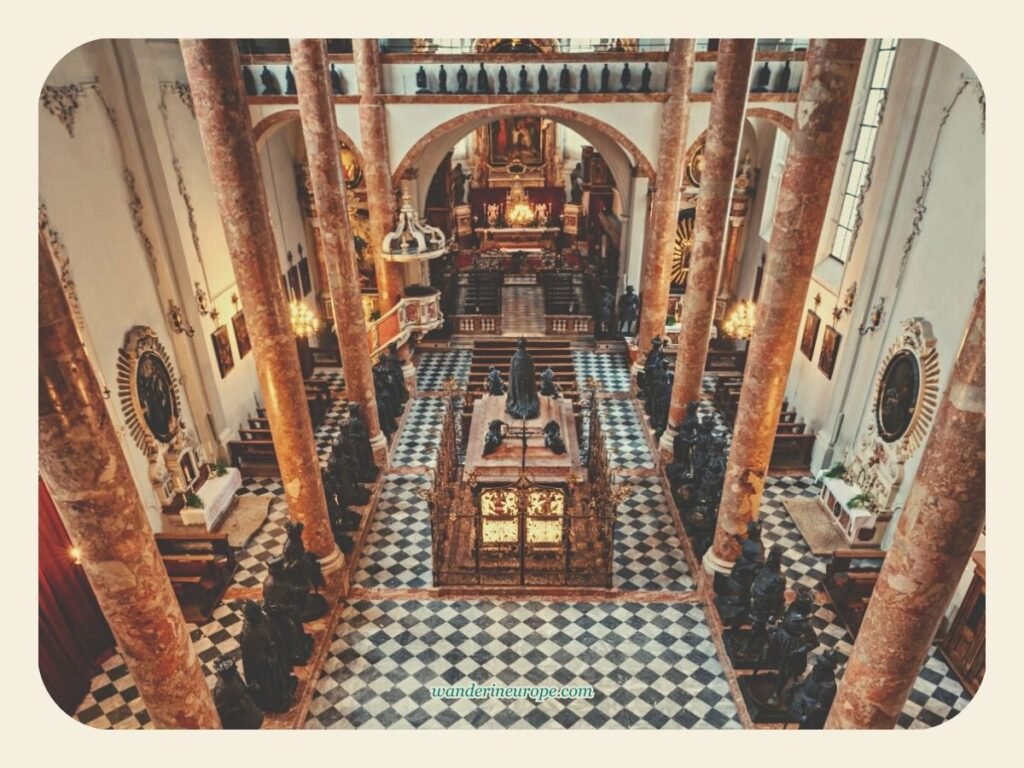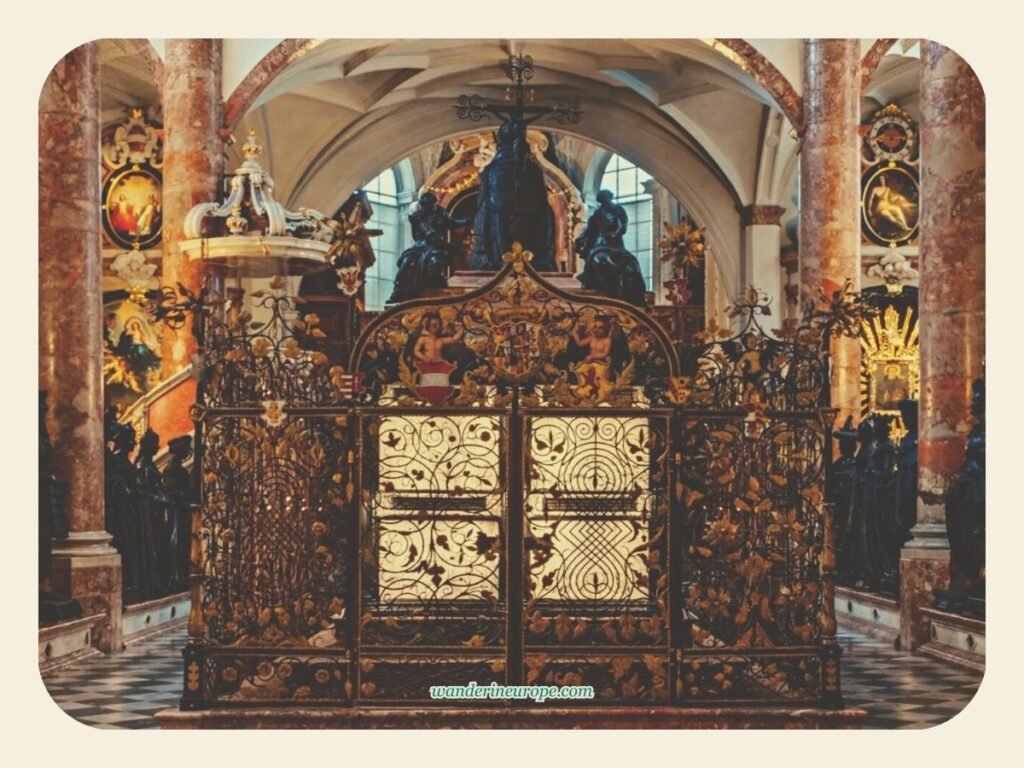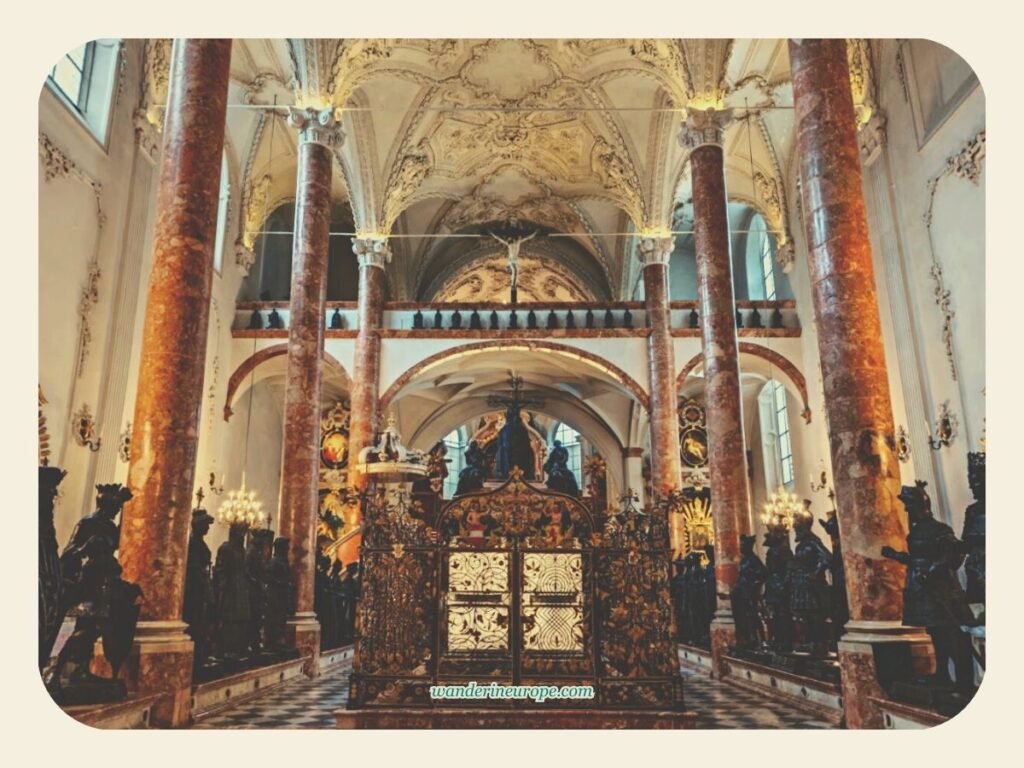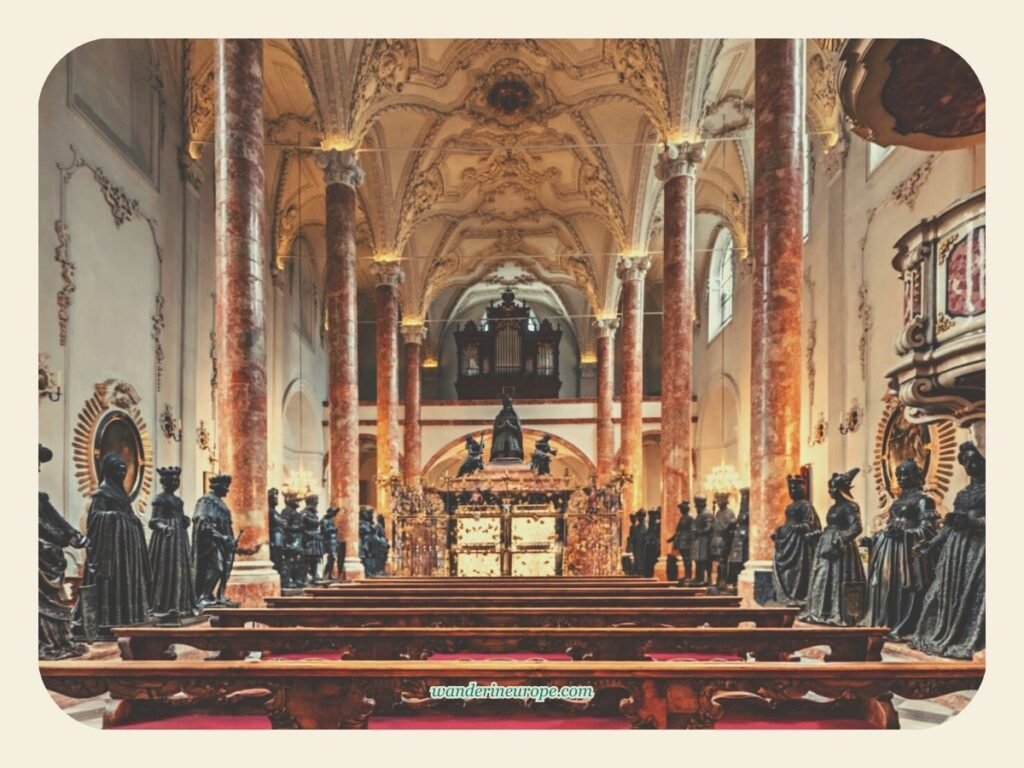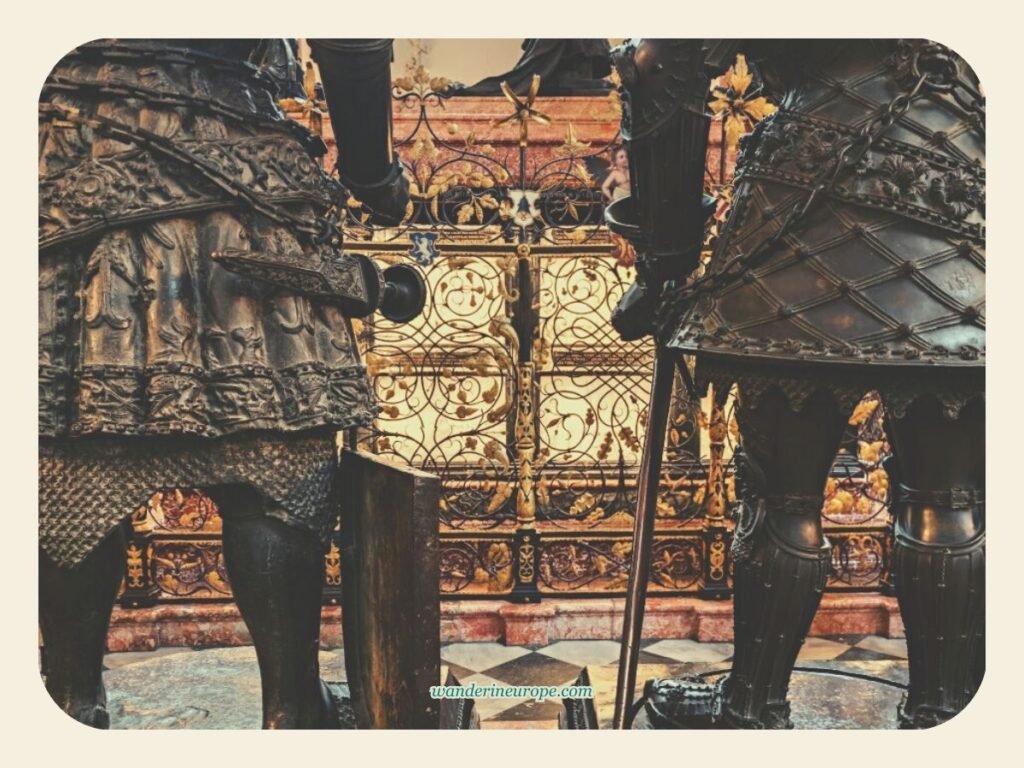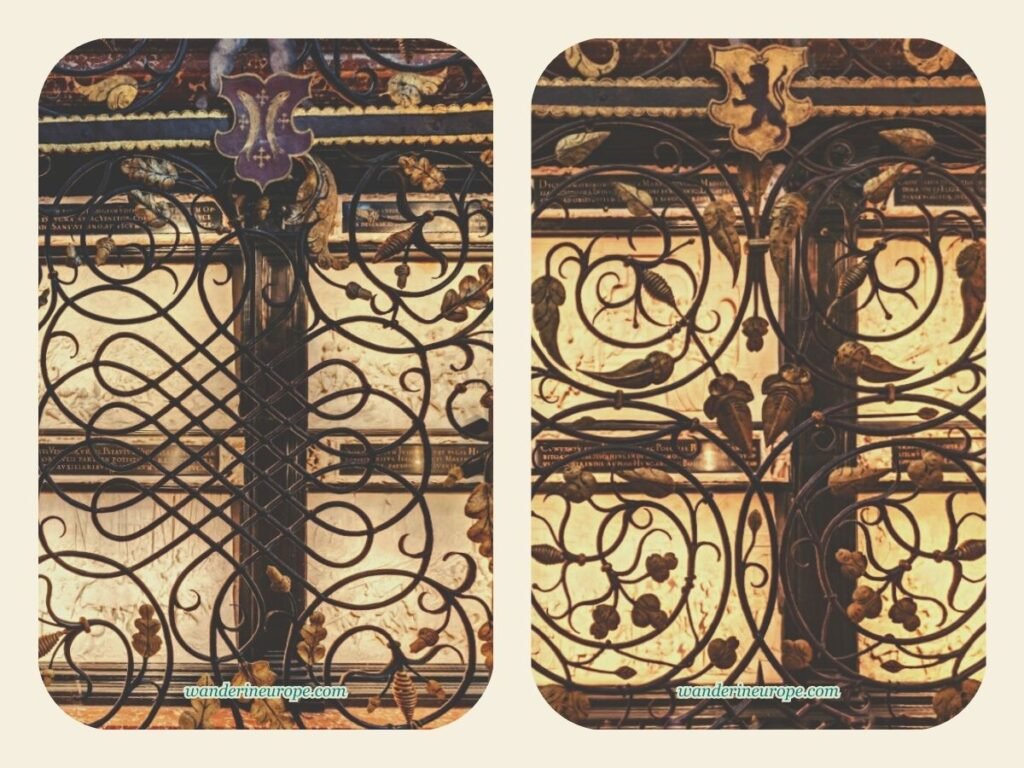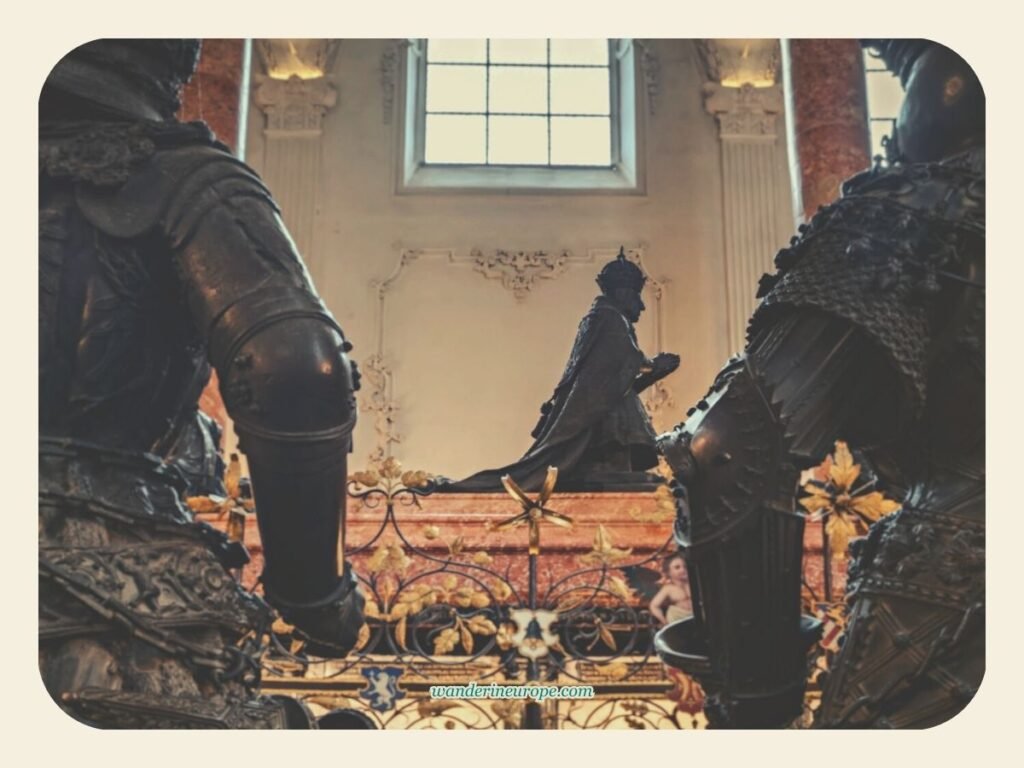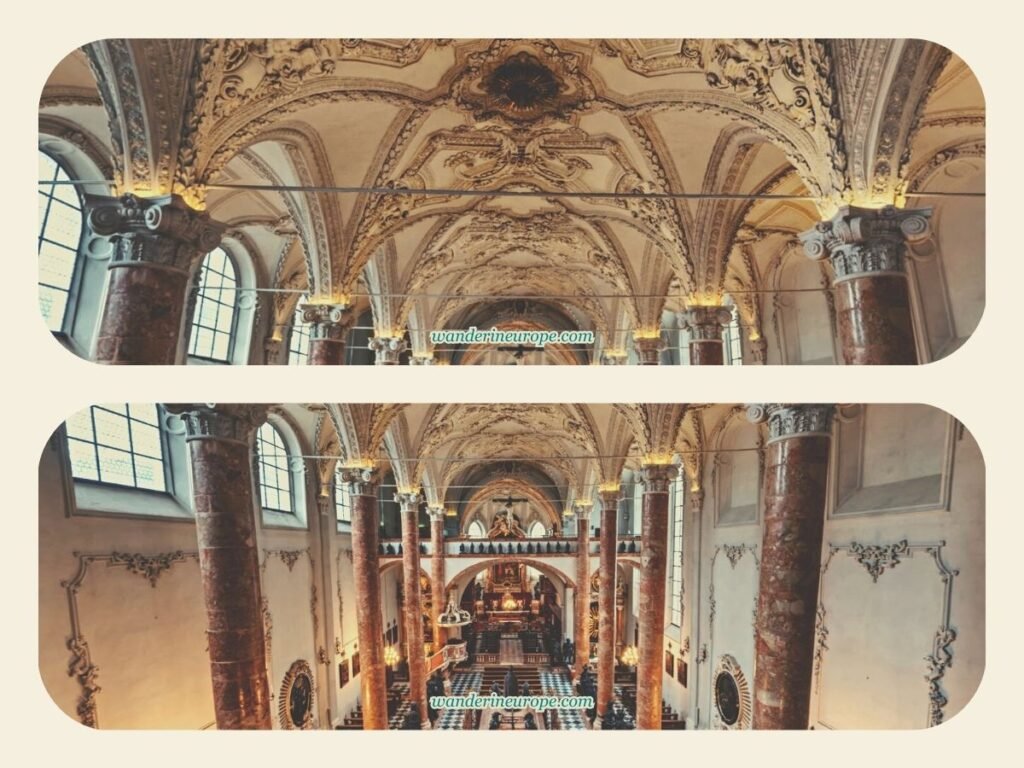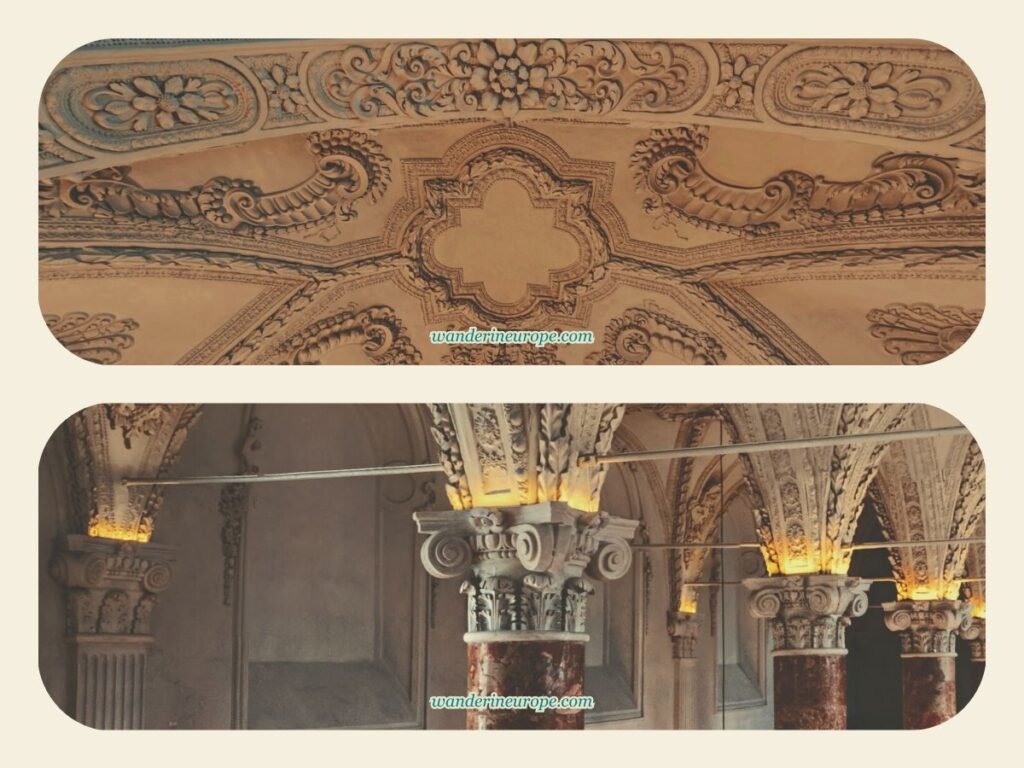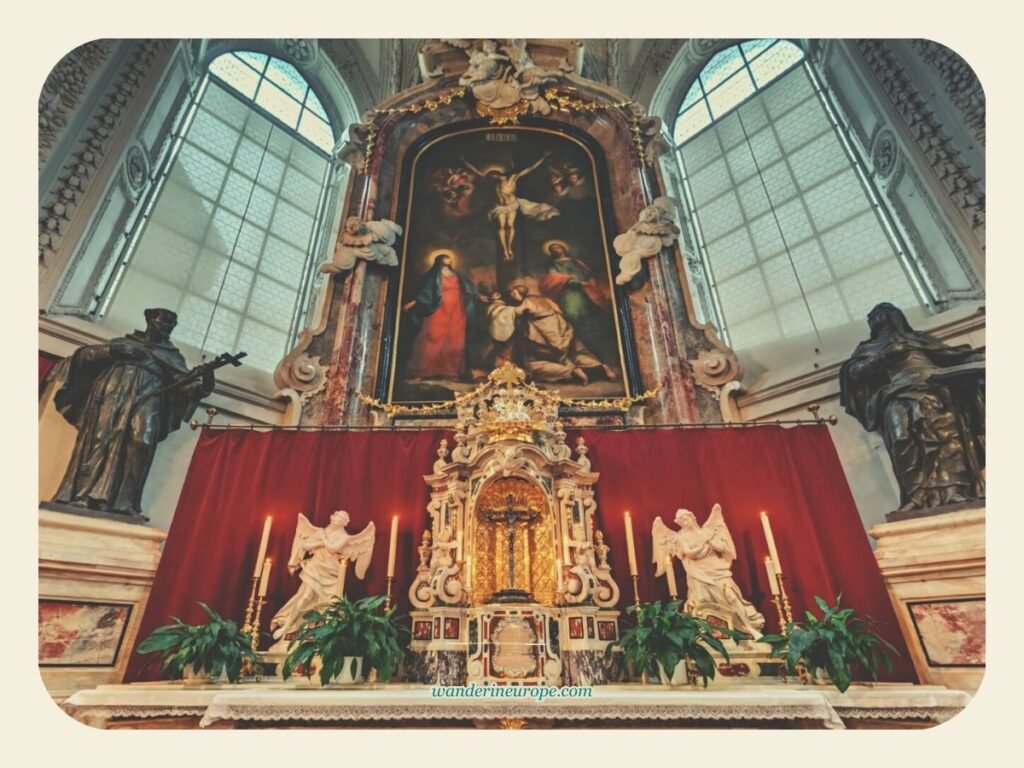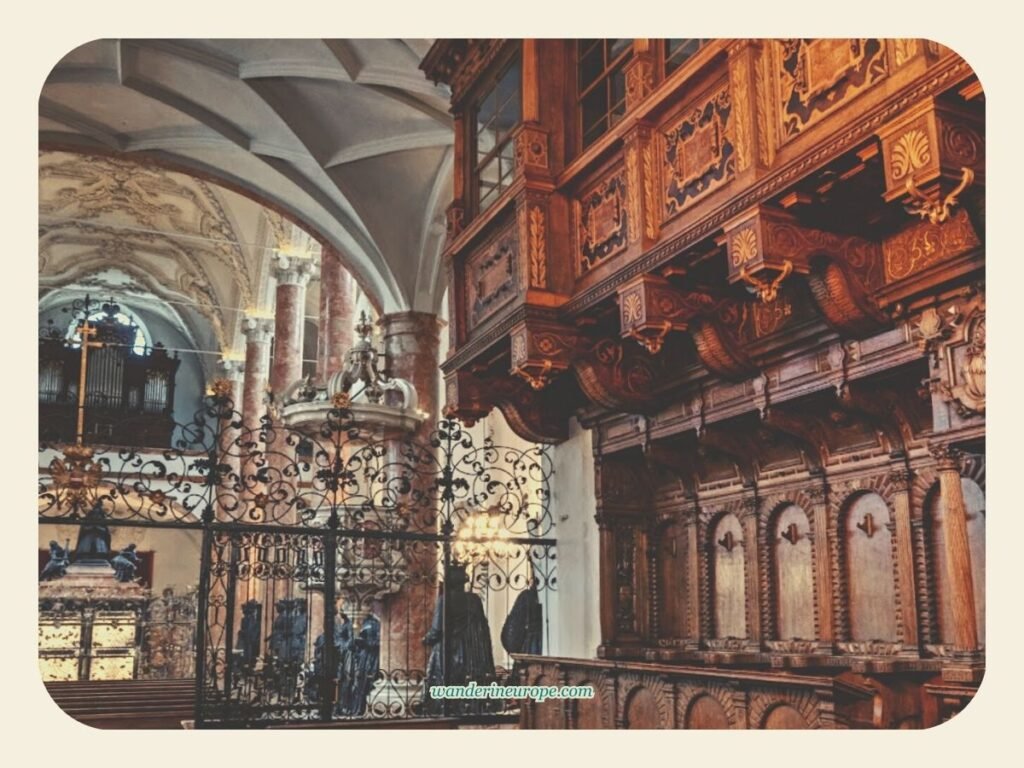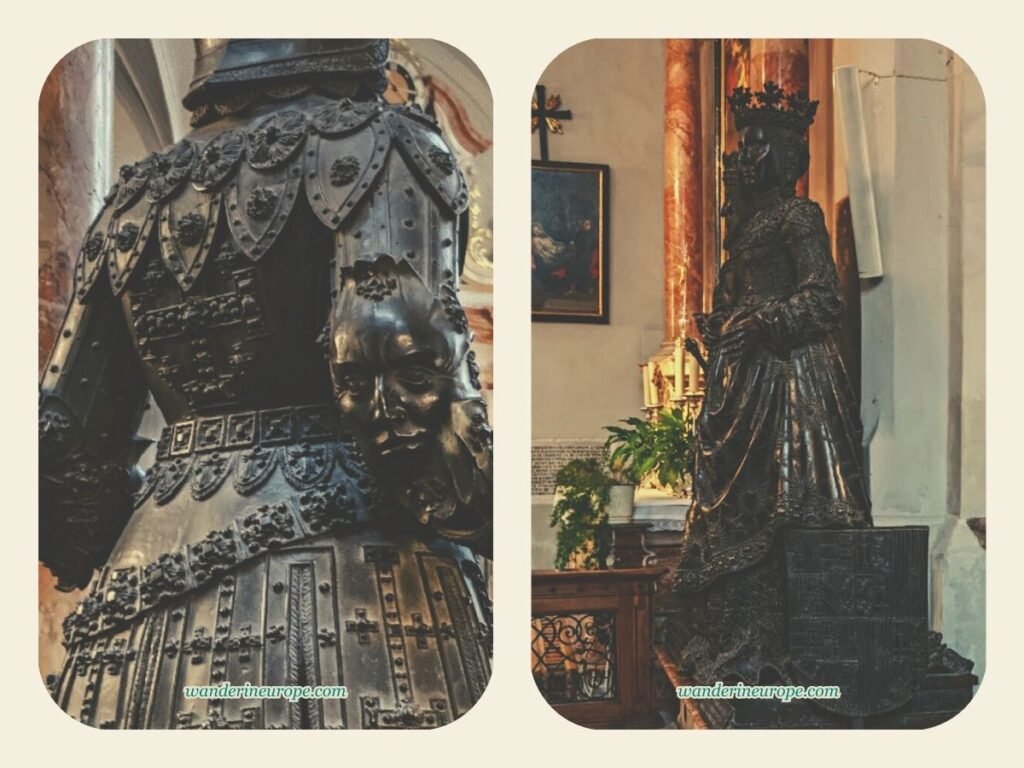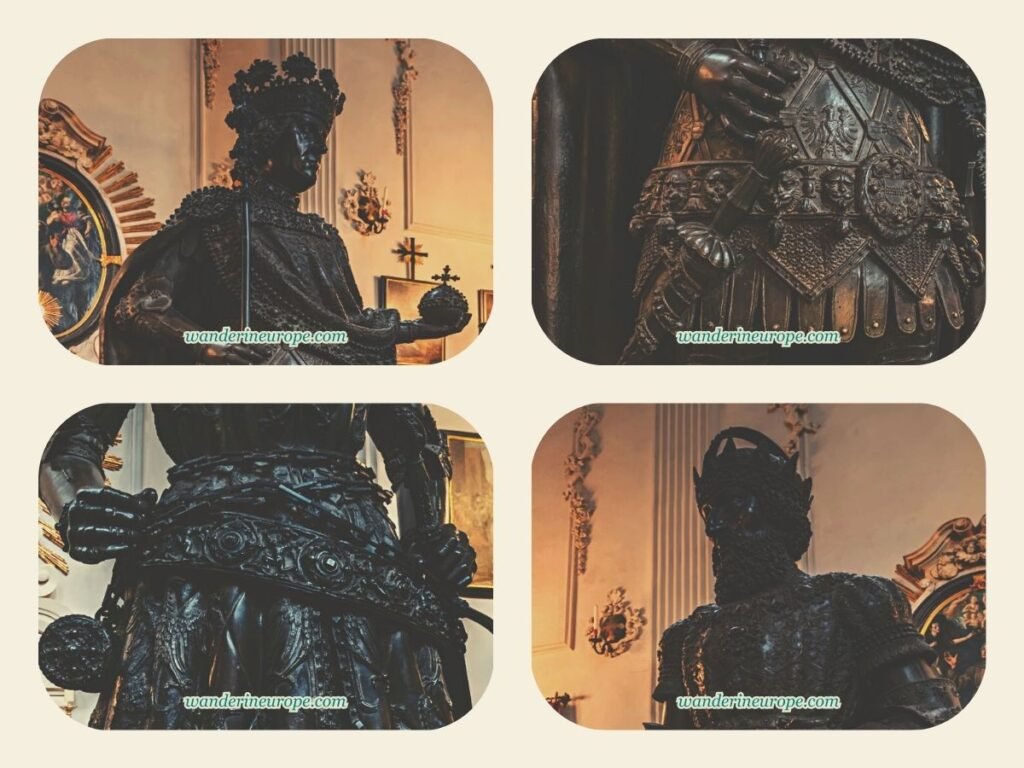Inside Hofkirche (Court Church) — Innsbruck’s Hidden Gem
This post might have affiliate links. This means we could earn a small commission if you make a qualifying purchase. No additional cost to you. More info: Disclosure
For every city, there’s always one attraction that really surprises us; an experience that makes our day. In Innsbruck, there are a few of these. But, as a wanderer, I’d say the best example would be Innsbruck’s Hofkirche, also known as the Court Church. To me, it is Innsbruck’s ‘don’t-judge-the-book-by-its-cover’ tourist attraction.
With only a few signs of its religious significance on its exteriors, I honestly mistook the Court Church for just another simple building in the city. The only way you would identify it as a church is by its main portal along Universitätsstrasse. However, despite its underwhelming facade, the Court Church can already leave you with an overwhelming first impression once you step inside. The treasures inside, the Black Men and the Cenotaph of Maximilian I, left me marveling for nearly half an hour.
So if you’ll be exploring Old Town Innsbruck, the Court Church is one of the unmissable places I’d recommend. Whether you’re visiting Innsbruck for just a day or having a 2-day trip, a visit to the Court Church is highly suggested!
What makes the Court Church more compelling is its location in the city. It’s very accessible and just minutes away from different scenic spots and beautiful places in Old Town Innsbruck. For example, the Court Church is just beside the Hofburg (Imperial Palace); it’s only a minute’s walk from the iconic Golden Roof, breathtaking Stadtturm (City Tower), and ornate Innsbruck Cathedral.
Beautiful Things Inside Innsbruck’s Court Church
There are four words to describe the things that await you inside the Court Church: Tirol’s most prized masterpieces. The most compelling are the Black Men and the cenotaph of Maximilian I. And the church’s architecture? Yes, it is also worth mentioning. These three are the highlights of the Court Church — the reason why it is worth visiting.
We’ll talk more about them as we go on.


Here’s the thing, though. There’s more to see in this church than just these three. Another is the Court Church’s mid-16th-century Renaissance organ, crafted by none other than Jörg Ebert from Ravensburg. Not only is it one of the oldest playable organs in the world, but it’s also widely regarded as one of the most important. If you happen to catch a concert while you’re visiting, you’ll be treated to the magical sight of its elaborate wing doors opening as its beautiful music fills the space.
Also, be sure not to miss the stunning clock next to the organ on the western wall of the choir. This beautiful timepiece, dating back to 1577, is housed in a wooden casing adorned with intricate metal ornaments that were popular during the late Renaissance.
1. Maximilian’s Cenotaph and Other Memorials
At the heart of the nave lies Maximilian I’s cenotaph – the centerpiece of Court Church’s historical significance. It’s a breathtaking monument full of art and beauty, from the intricate wrought iron grills to the marble reliefs and sculptures. Fun fact: Did you know that the work on most of the treasures that you’ll find inside Innsbruck Court Church began during the lifetime of Maximilian I? This includes his cenotaph, which he himself had envisioned.


More about Maximilian I’s Cenotaph + other monuments
By the way, who is Maximilian I? Maximilian I was the Archduke of Austria and the head of the Holy Roman Empire from the late fifteenth to the early sixteenth centuries. He is one of the most notable figures in Austrian history, with a legacy that includes military leadership, chivalry, architecture, cultural patronage, politics, and even the modern postal system.
The cenotaph in Innsbruck Court Church date back to the mid-16th century and was built by Emperor Ferdinand I as a memorial to his grandfather, Maximilian I.
Standing before Maximilian I’s cenotaph, you’ll be struck by the incredible craftsmanship on display — every detail is a testament to the emperor’s power and prestige. It’s a reminder of his important role in European history and his enduring legacy.
If you look closer at the cenotaph, you can already see the legacy of Maximilian I and the events in his life. They’re carved on the 24 reliefs of the emperor’s cenotaph. Some which are marked in my memory are the Marriage of Maximilian to Bianca Maria Sforza, Maximilian’s liberation of Vienna from Hungarians, Victory over Venice, and the Alliance of Holy League against France. You’ll also get a glimpse of what he looked like when he was still alive, thanks to the bronze sculpture of him in a kneeling and praying pose atop the cenotaph.
Around Maximilian I’s sculpture are the four other sculptures symbolizing the four cardinal virtues: Wisdom, Justice, Temperance, and Fortitude. His sculpture facing the altar of the church, he was portrayed as a very God-fearing, devout, and humble man…
If you are familiar with different styles of design, you’ll notice that the cenotaph of Emperor Maximilian I was created in the florid style of court Mannerism. This European art style, which emerged in the later years of the Italian High Renaissance in the early 16th century, is known for its asymmetrical and unnaturally elegant characteristics. It’s special. Maximilian I’s cenotaph is also special in terms of the materials used to create it. It’s made up of bronze and Hagau marble which is found in Northern Tyrol…
If you go to the back of the cenotaph, you’ll find two other memorials on the sides. If you are standing facing the cenotaph, to your left, you’ll find the tomb of Andreas Hofer, the national hero of Tyrol. To your right, you’ll see another memorial that commemorates the fallen soldiers who fought for the liberation of the fatherland.
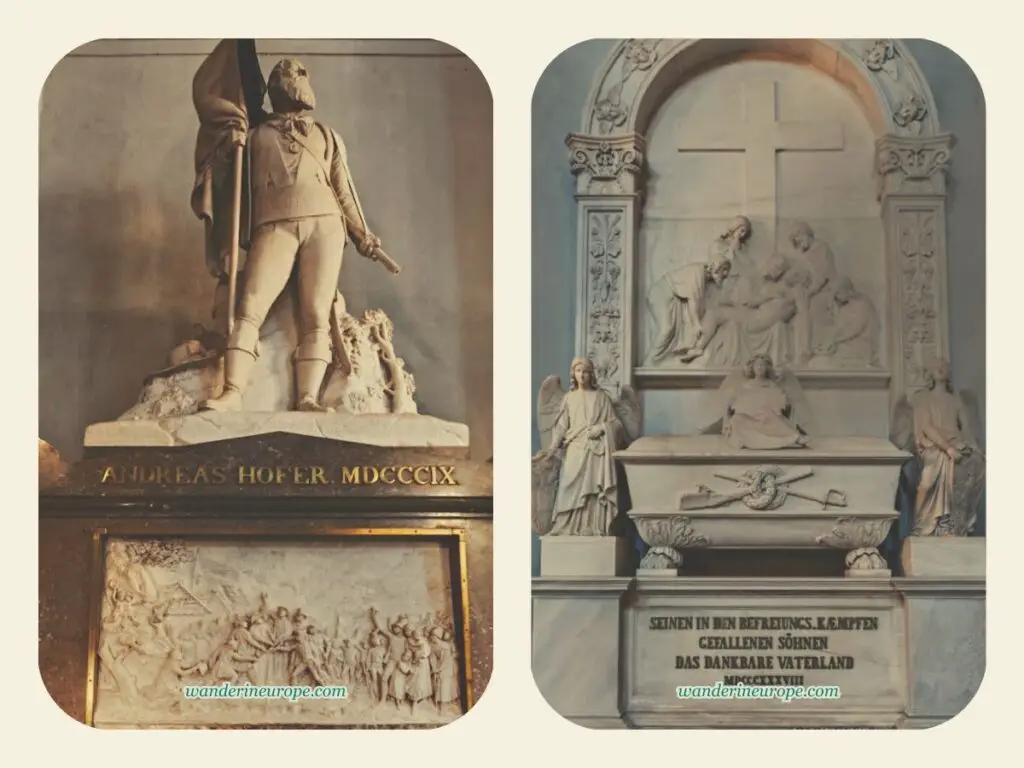
These two memorials commemorate the Tyrolean freedom fighters who fought against Napoleon’s armies to liberate Tyrol. They were the first in Europe to successfully resist Napoleon’s forces in several battles. Unfortunately, the freedom fighters were eventually defeated in a final decisive battle, which put an end to their efforts.
The Hofer monument consists of a pedestal with a relief and a large statue, both of which are significant in their own right. The almost three-meter-high Hofer figure is made of marble from Lasa and was crafted by Johann Schaller, while the relief, a work by Josef Klieber in Carrara marble, depicts the “Oath of Allegiance.” Together, these elements form a powerful tribute to Andreas Hofer and his role in Tyrolean history.
2. Beautiful Architecture of Court Church Innsbruck
While Europe is home to numerous magnificent churches, the Court Church in Innsbruck still stands out as a true gem. From the three naves with a setback three-sided choir to the round and pointed arch windows, every detail of the building’s exterior is a sight to behold. Like, as soon as you step inside the Court Church, your gaze will undoubtedly be drawn to the breathtaking interiors. The vaulted ceiling is a masterpiece in itself, adorned with intricate stucco designs that radiate elegance.


Details of the Court Church’s interiors + name of its notable artworks
You’ll also be greeted by galleries and high round pillars made of red marble as you enter the church. I like their white stylized Corinthian capitals, which seamlessly connect with the ornate ceiling. Looking up, you’ll also notice the church’s ribs in the galleries. They were made from sandstone material from Mittenwald. Preserved, these ribs are one of the things that add authenticity to the interiors of the church.
The high altar in the Court Church choir is also a sight to behold. It boasts a magnificent high altar adorned with a breathtaking painting of the crucifixion by J.C. Auerbach, based on a sketch by the esteemed Viennese court architect Nicolaus Pacassi.
The choir is also home to meticulously crafted wooden stalls and elaborate iron-wrought grills, which only add to the church’s already mesmerizing atmosphere.
To emphasize the beauty and importance of the Court Church Innsbruck, three works of art are worth mentioning. They all showcase the incredible artistry that went into the construction of this church.
- The left altarpiece by Michael Waldmann the younger,
- the Baroque crossroad station pieces by Johann Michael Hudetz,
- and the “Fürstenchor” (Princes’ Chancel) with magnificent intarsia by Hans Waldner from Ravensburg and Konrad Gottlieb from Innsbruck
Fun fact: The construction of the Court Church Innsbruck was led by Nikolaus Türing, whose grandfather built the Golden Roof. However, after Türing’s death in 1558, stonemason master Marx della Bolla took over the responsibility for the construction. Despite this change, the outcome is still a stunning example of the beauty of the transitional period between the German late Gothic style and the Renaissance.
3. The Black Men — Unique Discovery in Court Church Innsbruck
The Court Church’s interior is a true feast for the eyes, featuring a plethora of artistic wonders that range from mesmerizing stucco works and vibrant paintings to intricate wooden stalls.
However, nothing quite compares to the statues called “Black Men.” It’s Court Church’s unique treasure, a must-see for every Innsbruck visitor. In essence, the Black Men is a collection of twenty-eight larger-than-life bronze statues depicting historical figures, including Maximilian’s ancestors and heroes. These statues are a true masterpiece of the High Renaissance, showcasing breathtaking artistic design and incredible richness of detail.


Each sculpture of the Black Men serves as a stunning, lifelike representation of the person it depicts, with the sculptor skillfully capturing even the smallest details of their robes, armor, and even their hair!
Among the 28 sculptures, there are 8 that I really liked the most. They’re the ones to the right of the cenotaph (between the cenotaph and Silver Chapel). Starting from the second column, going to the back of the church: King Arthur, King Ferdinand of Portugal, Duke Ernst “the Iron of Austria,” Theodoric “the East Goth King,” Duke Albert II “the Wise of Austria,” King Rudolf I, King Philip the Fair of Castile, and Clovis the King of the Franks.
Visiting Information Court Church Innsbruck
So, how did you find Innsbruck Court Church? It’s AMAZING, isn’t it? Now, if you want to visit the Court Church, below are the information
The Hofkirche is open from Monday to Saturday, from 9:00 a.m. to 5:00 p.m., and on Sundays and holidays from 12:30 a.m. to 5:00 p.m. The last entry is at 4:30 p.m. Visitors can purchase a single ticket for 9 EUR (regular) or 7 EUR (reduced). Children and young adults under 19 years of age can enter free of charge.
Good to know: You can enter Court Church Innsbruck for free if you are a holder of an Innsbruck City Card, which is good thing to have if you’re visiting Innsbruck. It lets you go into museums and attractions one time, ride buses and trams for free, use a special bus that you can get on and off whenever you want, take a shuttle bus to the Swarovski Crystal Worlds, and ride cable cars. This card can save you money and make it easier to get around and see the important places in the city
The Court Church of Innsbruck is now run as a museum and is part of the Tyrolean Regional Museums. As a result, visitors are directed to the Tyrolean Folk Art Museum to enter the Court Church. A sign in front of the main portal of the church provides instructions on how to enter.
After entering the museum, you must pass through the beautiful cloister of the former Franciscan monastery to reach the Court Church. Along the way, you will have the opportunity to admire another work of art, the Eduard Wallnöfer bust by Rudi Wach.
The cloister is a serene and peaceful place, providing visitors with the perfect setting for contemplation and introspection. Taking a moment to reflect here can help make your Innsbruck trip even more meaningful and fruitful.
Prior to entering the church, visitors will be treated to a multimedia show that tells the exciting story of Maximilian’s life. This show provides an excellent introduction to the Court Church and offers valuable insights into what visitors can expect to see during their visit.
How Long To Spend In Court Church?
Hofkirche, or the Court Church, may be a normal-sized city church in Innsbruck, but it is packed with historical and artistic treasures that are definitely worth exploring. While an hour may be enough time to see the highlights of the church, I would suggest giving yourself a bit more time to fully appreciate all that it has to offer.
Take your time to marvel at the intricate stucco works, admire the beautiful paintings, and study the intricate wooden stalls and iron wrought grills. And, of course, don’t forget to spend plenty of time marveling at the stunning bronze statues of the Black Men surrounding Maximilian I’s cenotaph.All in all, the Court Church is a true gem of Innsbruck that you won’t want to rush through.
Resources: Court Church Innsbruck
That’s it! I’ve shared everything I know about the Court Church Innsbruck. But if you’re hungry for more information about this stunning church, here are some resources to get you started:
- Innsbruck Official Tourism website (Court Church page)
- Court Church (Wikipedia)
- Tyroler Landesmuseen (Court Church visiting Information)
Hey there, I believe you’re looking for a beautiful place to visit in Innsbruck for your trip. If you need accommodation, I recommend my partner’s hotel and booking platform. It’s what I always use and I find the hotel deals to be pretty amazing! Please note that the link is an affiliate link. If you book through it, I may earn a small commission at no extra cost to you. It’s a great way to support WanderInEurope in its aim to write informative posts for wanderers like you. Thank you for your support!”

Once you’ve finished visiting Hofkirche and the rest of Old Town Innsbruck, it’s a good idea to move on to nearby attractions that offer immersive, breathtaking, and historical experiences. These include Nordkette (the nearest mountain attraction), Ambras Castle (a romantic destination and the oldest museum), and the Tirol Panorama Museum (a historical artwork with breathtaking scenery outside). Check them out!
Links open in a new tab.





